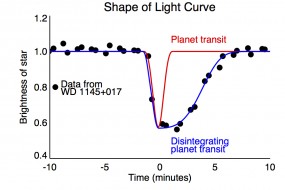Astronomers have detected debris around a white dwarf that might be from one or more disintegrating rocky bodies.

CfA / A. Vanderburg
Most stars — including the Sun — will one day use up their nuclear fuel and turn into glowing cinders called white dwarfs. The planets around these stars will suffer various fates, but generally not good ones: they might be eaten as the star swells into a fat, fluffy red giant; smashed into other planets by the star’s changing gravitational influence as it puffs up and spews out winds; or roasted like a marshmallow come too close to the flame. Among other options.
White dwarfs generally have hydrogen and helium atmospheres, with the heavier elements (such as carbon and silicon) sunk far below. But roughly a third of the white dwarfs astronomers have observed have atmospheres mysteriously tainted by these elements. Plus, they’ve seen a few dwarfs circled by debris disks. So they’ve suspected for some time that these white dwarfs are covered in the crumbs of their munched planets.
Andrew Vanderburg (Harvard-Smithsonian Center for Astrophysics) and colleagues have now detected at least one potential disintegrating planetesimal around the white dwarf WD 1145+017. The object revealed itself when it passed repeatedly between us and the white dwarf, creating a weird transit pattern in the white dwarf’s light. When first observed with the Kepler spacecraft in 2014, the star's light only dipped a wee bit but for about an hour. When observed nearly a year later with multiple ground-based telescopes, the star's brightness dropped by an incredible 40% for 5 minutes. Neither of these results makes sense for a run-of-the-mill planet and dwarf: white dwarfs are about the size of Earth, and a body passing in front of them should take a mere minute to transit. The transits also weren't symmetric.
As the team reports in the October 22nd Nature, the object — or maybe even six or more objects, all about the size of the asteroid Ceres or smaller — orbits the white dwarf closely in about 4½ hours and seems to be trailing a comet-like tail. Spectroscopic measurements reveal heavy elements in the white dwarf’s atmosphere, too, like those found in the solar system’s rocky planets. The star also has a dusty debris disk.
If indeed the funny-looking signals come from a disintegrating rocky planet, WD 1145+017 adds to growing evidence that the “pollution” in these white dwarfs’ atmospheres comes from torn-up worlds. These planets might be destroyed and eroded by the aging star’s heat and winds.
You can read more about the discovery in the press releases put out by NASA Ames and the Harvard-Smithsonian Center for Astrophysics.
Reference: A. Vanderburg et al. “A disintegrating minor planet transiting a white dwarf.” Nature. October 22, 2015.
Want to learn more about astronomy? Subscribe to Sky & Telescope magazine!
 2
2









Comments
Tom Hoffelder
October 27, 2015 at 11:49 am
Interesting and well written article, but are we sure the debris are not the remnants of a destroyed Dyson sphere? JUST KIDDING! Always nice to see science articles untouched by sensationalism.
You must be logged in to post a comment.
Camille M. CarlislePost Author
November 3, 2015 at 11:52 am
We debated whether to mention that possibility, but decided to leave it to our savvy readers to make such connections. 😉
You must be logged in to post a comment.
You must be logged in to post a comment.